Background
The primary role of GMW water storages is to harvest and store customers' water entitlements. GMW’s water storages are not designed or operated specifically for flood mitigation, although they do provide downstream flood peak reduction benefits where possible.
The level of flood mitigation that a water storage can provide depends on the operating rules of the storage, the size of the flood event, the level of water in the storage at the beginning of the event, the capacity of the storage and the capacity of the spillway.
Water storages may provide significant mitigation for small floods and may significantly reduce downstream flooding. The storage’s ability to mitigate downstream flows so they remain below flood thresholds reduces as floods become larger.
Floods
Floods are natural events occurring on a regular basis in Victoria. As a dam owner, GMW must be prepared to manage these events to minimize their negative and maximize their positive impacts as far as is possible within its control.
The Victorian Government requires GMW to publish the policies on pre-releasing water and surcharging water levels in gated water storages set out in this document.
Understanding the way GMW operates its storages during flood events aids agencies and communities to plan their responses to such events.
Relevant Guidance
Recognizing that every flood event is different, relevant guidance material and learnings from previous events inform GMW’s decision-making. Some of these documents are:
- State Emergency Response Plan – Flood Sub-Plan (EMV, 2021);
- State Emergency Management Plan - Flood Sub-plan (SES, 2022)
- Victorian Floodplain Management Strategy (DELWP, 2016)
- Dam Safety Response Plan (DELWP, 2019);
- Emergency Notification and Response Protocol between DELWP and Victorian Water Corporations;
- Emergency Management Manual Victoria (https://www.emv.vic.gov.au/policies/emmv/)
- Service Level Specification for Flood Forecasting and Warning Services for Victoria (BoM, 2013);
- Guideline for the use of rainfall forecasts to make releases from dams in Victoria Guideline for the use of rainfall forecasts to make releases from dams in Victoria (water.vic.gov.au) (DELWP, 2022)
- Various reviews and reports of past flood events including the 2011 Queensland and Victoria Floods.
Spillways
Spillways provide for the safe release of floodwaters from a water storage.
Spillways are generally large concrete structures beside or within a water storage embankment. When storages are full, excess water from inflows is released through the outlet works (for small flows) or over the spillway (larger flood flows).
Every storage has a certain capacity to store water. If the storage is full and floodwater enters it, the water level will rise and may eventually overtop the dam crest. To avoid this the spillway passes the flood downstream by drawing water from the top of the reservoir.
Spillways can be controlled or uncontrolled. An uncontrolled spillway has a fixed crest. A controlled spillway has gates that can be raised or lowered.
Most GMW water storages have a fixed crest spillway. To maximize spillway capacity, the crest of the spillway is “Ogee” shaped to conform to the water flowing over it, taking the shape of an elongated letter “S”. Ogee crest spillways can be either uncontrolled or controlled.
Uncontrolled Spillway
If a flood enters a full reservoir with an uncontrolled spillway, the water level will rise and water will simultaneously start flowing out through the spillway. The water level in the reservoir will continue to rise for some time and so will the discharge over the spillway. After reaching a maximum, the reservoir level will fall and eventually return to the full supply level.
Freeboard is the space between the full supply and the crest levels of a water storage. The space between full supply level and the design flood level is termed “wet” freeboard. The space between design flood level and the water storage crest is termed “dry” freeboard. Dry freeboard accommodates wave action on the reservoir while wet freeboard allows for temporary surcharge storage during floods.
 Freeboard - wet and dry
Freeboard - wet and dry
Surcharge storage is the storage available between the design flood level and the reservoir full supply level. This is only a temporary storage for reservoirs with uncontrolled spillways.
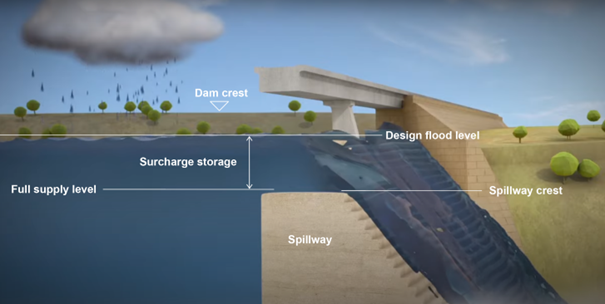 Temporary surcharge storage
Temporary surcharge storage
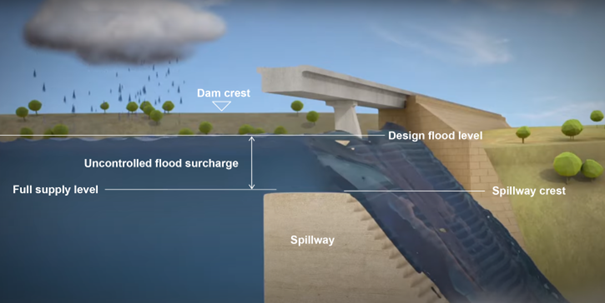 Normal flood operation on an uncontrolled spillway
Normal flood operation on an uncontrolled spillway
Controlled spillway
A controlled spillway allows water to be stored above the spillway crest level by keeping the spillway control gates closed. The gates can open to pass a flood. Controlled spillways allow more storage for the same height of the water storage
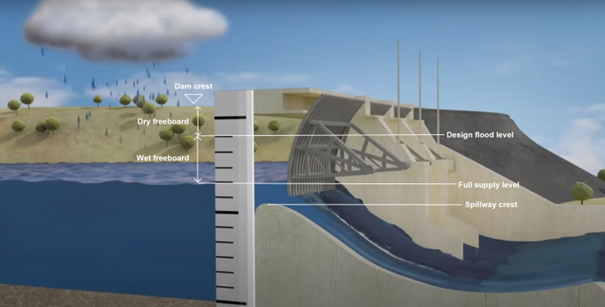 Freeboard - wet and dry
Freeboard - wet and dry
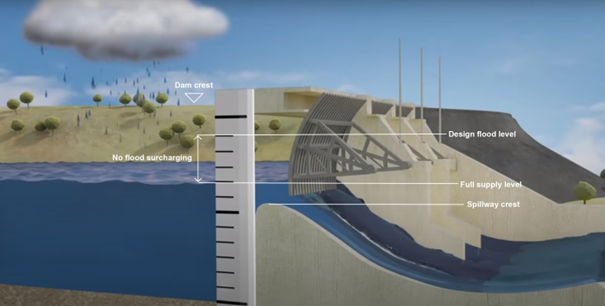 Normal flood operation without surcharging on a controlled spillway
Normal flood operation without surcharging on a controlled spillway
Controlled flood surcharging
Controlled flood surcharging can occur when storage inflows exceed forecast, causing the storage level to exceed full supply level. Storage operators diligently monitor rainfall, storage inflows and the storage level to minimize the risk of this form of surcharging. Controlled flood surcharging can also occur with deliberate decisions to allow the storage to exceed full supply level by slowing the rate at which the spillway gates open on a rising flood inflow or close on a falling flood inflow.
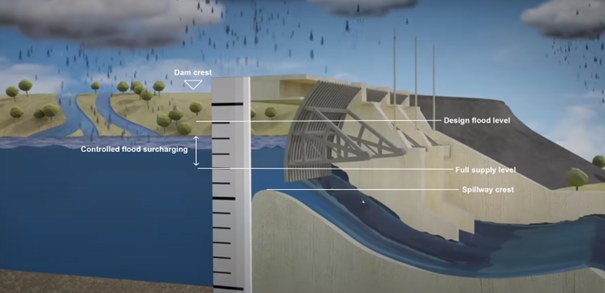 Controlled flood surging
Controlled flood surging
Uncontrolled flood surcharging
During large floods, as spillway gates open and spillway flows increase the gates have progressively less impact on the spillway discharge and reach a point where they open clear of the flowing water. At this point surcharging changes from controlled to uncontrolled. The spillway then acts in the same manner as the uncontrolled fixed crest spillway described above.
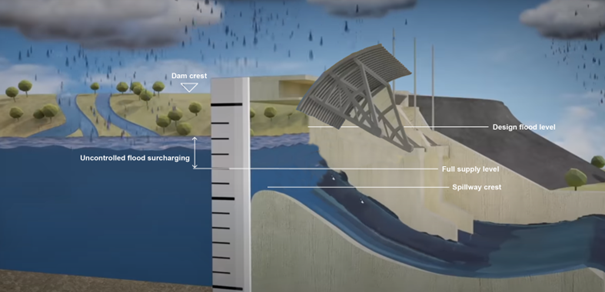 Uncontrolled flood surcharging
Uncontrolled flood surcharging
What is surcharge?
Surcharging is a condition where the water level in a storage inadvertently or deliberately rises above the designed or agreed FSL for that water storage.
GMW operates 16 large water storages. The designs of 15 of these structures include a FSL and Freeboard provision. The exception is Mildura Weir, which has no design freeboard.
The spillway structure and freeboard allowances are critical elements in the design of any water storage. They allow safe passage of design flood flows from the storage without the stored water rising above the structure crest, potentially causing the storage to fail.
Most GMW water storages have fixed spillway crests. These storages start to spill once their water levels exceed the level of the spillway crest, and continue to do so until inflows reduce and water levels return to the spillway crest level.
Some water storage spillways use gates to regulate the flow. GMW’s gated spillways are Lake Buffalo, Lake Eildon and Cairn Curran Reservoir. Weir structures managed by GMW at Yarrawonga, Torrumbarry, Mildura and Goulburn Weir also have gated spillways. GMW maintains FSL at these storages by adjusting the release through the outlet works and/or spillway gates in accordance with operating procedures.
To protect the structural integrity of the water storage, flood operation should not exceed FSL for any longer than necessary. Minor unavoidable surcharging may occur during flood routing due to operational constraints.
Gated spillways and outlet works allow flood discharges to pass at a rate determined by the water storage owner. It is possible to control operation to change the characteristics of a flood release by manipulating the duration and magnitude of releases, and deliberately choosing to surcharge the storage in doing so.
Storage safety implications, flood mitigation benefits and water harvesting objectives of storage surcharging must be reconciled through operational procedures.
GMW FIMPs provide these procedures for all storages, and recognise any applicable constraints and limitations in flood routing procedures.
Below is an example of how holding water within the storage (surcharging) during a rainfall event can help to reduce the peak outflow. This action raises the water level within the storage above full supply level. The excess water is released when the flooding risk downstream has passed and the storage returns to full supply level.
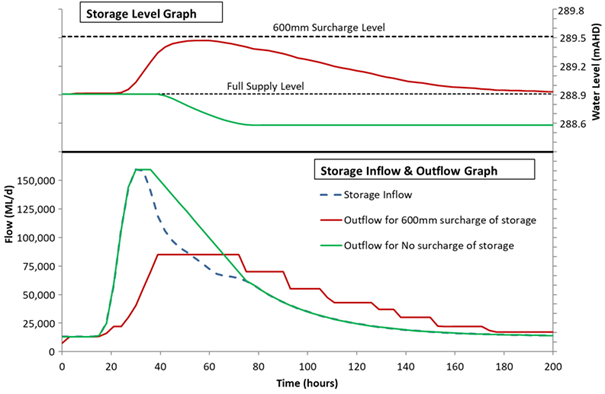 Example hydrograph with and without surcharging
Example hydrograph with and without surcharging
Pre-releasing means releasing water to manage the level in a storage prior to forecast rainfall and resulting inflows to reduce subsequent downstream peak flows.
As water storages exist primarily to harvest and store water for entitlement holders, a main consideration for pre-releasing water is the level of confidence that the water can be recovered. Releasing more water than is received from inflows would have a negative impact on the availability of water for entitlement holders and others who rely on the water for their livelihoods.
It is impossible to know how much water will flow into storages based on rainfall forecasts. Catchment conditions, actual rainfall, how quickly and where rain falls, all play a part in how much water flows into storages. GMW will consider pre-releasing when it expects inflows to be greater than the available airspace and releases may be required to pass the flood safely. Drawdown of storage levels can only occur prior to a rainfall event once an accurate rainfall forecast is available from the Bureau of Meteorology, generally 3-4 days in advance. This limits the volume of water available for release.
The volume, rate of discharge and timing of pre-release decisions will be determined after considering the following factors:
-
- releases will not compromise the ability of those downstream to prepare for a flood or manage during an existing flood
- the degree of confidence that any water released can be recovered to protect the reliability of supply
- downstream levels not exceeding the level that would have occurred naturally
- the time of season and seasonal conditions.
Making pre-releases does not prevent flooding downstream. Large inflows the storages receive are likely to be well in excess of the volume pre-released. In this instance, pre-releases are unlikely to change the peak downstream flows.
Below is an example of how pre-releasing water prior to inflows from rainfall can help to reduce the peak outflow. This illustrates how releasing water early enabled the peak outflow (outflows indicated by the dotted orange line) to be lower than the peak inflow (green line) and the peak outflow under a scenario where pre-releases did not occur (solid orange line). This example also shows that the storage volume reduced due to the pre-release, highlighting the risk of releasing water that may not be recovered if the flows into the storage do not increase. FSL refers to the full supply level of the storage.
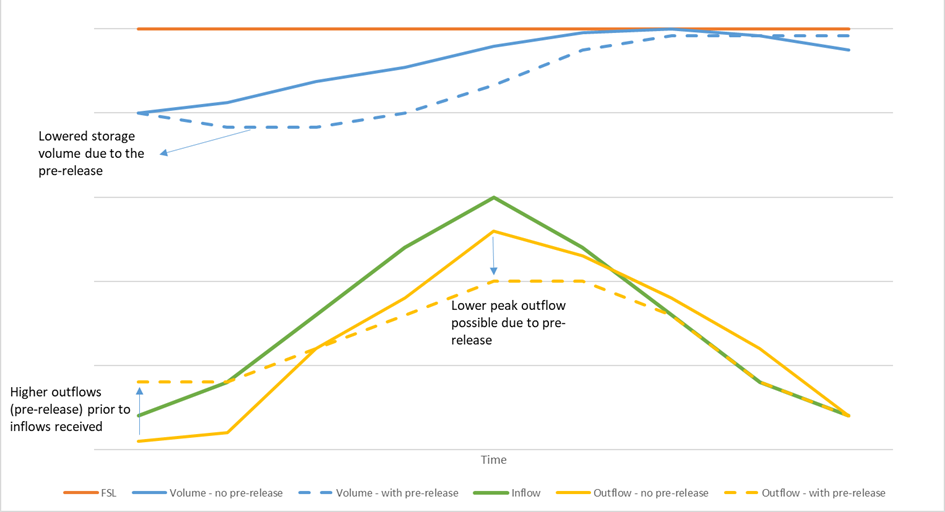 Example hydrograph with and without pre-releasing
Example hydrograph with and without pre-releasing
Summary
Pre-Releasing can reduce the magnitude and duration of downstream flooding flows and associated impacts. Surcharging will reduce the magnitude of downstream flooding, but most likely increase its duration.
Pre-Releasing increases the risk to system reliability and reduces the risk to structural integrity. Surcharging can increase structural risk significantly, and does not affect system reliability.
Definitions
GMID means the Goulburn Murray Irrigation District, which is comprised of irrigation channels to deliver water to irrigators and drains to remove excess surface water.
Flooding means river flows downstream of GMW water storages that exceed a flood class level as defined by the Bureau of Meteorology.
Flood Incident Management Plans (FIMP) are developed for each storage and used to direct operations before, during and after a flood event.
Freeboard is the vertical distance between a stated water level and the top of the non-overflow section of a water storage structure.
Full Supply Level (FSL) is the maximum normal operating level of a storage, as defined in GMW’s Key Dam Data for that storage.